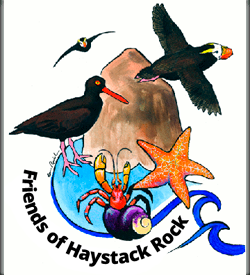“Where did Haystack Rock come from?”
Geologic History of Haystack Rock
Millions of years ago, the Pacific Northwest looked quite different. What we know as the eastern border of Oregon, Washington, and Idaho was a site of violent volcanic activity. Fissures spewed hot molten lava that reached the West coast in only a few days!
The lava flowed through low-lying valleys and over the smaller Cascade Mountain Range. As it reached the ocean shore, it sank down into the soft sediments, cooling and hardening into thick black basalt. Over the millions of years that followed, tectonic plate movement pushed the basalt formation upwards, and erosion carved away the softer sediments and stones, leaving the dramatic rocky coastline that is still in transition today.
The view above, from Ecola State Park, illustrates the Oregon Coast’s geological past. High mountains from lava flows tower over the shoreline. They are continually uplifted by the subducting oceanic plate below, and eroded away by the sea. You can see Haystack Rock furthest back, on the right.
Yellowstone Hotspot
One of the most often asked visitor questions about Haystack Rock is “Where did it come from?” To answer this question, HRAP staff and volunteers begin at the beginning — over 15 million years ago at a very active place known as the Yellowstone Hotspot. A hotspot is a volcanic region fed by an underlying mantle. Molten rock, or magma, rises through a plume from the mantle to the surface, spreading lava over the earth and creating new land mass. There are a number of still active hotspots around the globe. In addition to Yellowstone, we have Hawaii, Iceland and Galápagos, to name a few.

Source: http://en.wikipedia.org/wiki/Yellowstone_Caldera
Over 300 separate flows emanated from Yellowstone over the next 11 million years, though geologists believe that most of the volume spread over the Pacific Northwest in the first half-million years or so. A few of these flows made it to the Pacific Ocean, including our own Gingko Flow, which in the space of a week traveled over 300 miles to what is now Cannon Beach, burrowing into the soft ocean sediment and in various spots re-erupting on the sea floor (then 1,000 feet lower than it is now), forming secondary, or “submarine” volcanoes. The now-eroded throat of one such formation is Haystack Rock.
Some very recent events show how geologic formations and activity stay connected through long stretches of time. During the summer of 2014, the National Park Service closed portions of Yellowstone National Park due to the overheating (from beneath) of some of the asphalt roads that traverse the Park. The same hotspot that gave us Haystack Rock 15 million years ago was now turning Yellowstone’s roads into oatmeal. If nothing else, geology can give us perspective.
Cascadia Subduction Zone

Source: http://en.wikipedia.org/wiki/Cascadia_subduction_zone
Haystack Rock has spent much of its existence underwater, emerging over time through a process called continental, or tectonic, uplift. As our own Juan De Fuca Plate subducts (drives under) the lighter North America Plate, the latter rises, lifting the Rock to its present intertidal state.
All of this activity is taking place directly over the Cascadia Subduction Zone, also known as the Cascadia Fault, a convergent plate boundary that stretches from Vancouver Island to Northern California. The tectonic processes active in this subduction zone region include accretion (increase in land mass), subduction, deep earthquakes and active volcanism, including such notable eruptions as Mt St. Helens in 1980. One of the most significant effects of sitting atop this tectonic fault zone is the occasional “megathrust” earthquake (8.0 or higher), which occurs in the Pacific Northwest every 300-600 years or so, the last occurring in the year 1700. Experts predict the next rupture of the Zone may be responsible for widespread destruction throughout the region.There are 19 volcanoes located above the Zone, including Mt Ranier and Mt Shasta. The most active are Mt Baker, Lassen Peak, Mt Hood and of course, Mt St. Helens.

